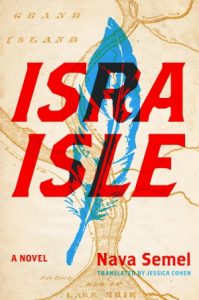 translated by Jessica Cohen
translated by Jessica Cohen
November 1, 2016
240 pages
This spellbinding alternate-history is not just one story, but three.
In Isra Isle, Nava Semel draws on historical fact and an optimistic alternative future to explore the ramifications of a Jewish state located in the United States and established in the early 19th century. Prior to Theodor Herzl and the dream of a Jewish homeland in what is now Israel, there was Mordechai Manuel Noah, a journalist, diplomat, and playwright who purchased Grand Isle, near Niagara Falls, from Native Americans in 1825 and tried to establish “Ararat,” where Jews from around the world could settle in peace. Needless to say, Noah’s dream never came true.
Semel begins the novel in September 2001 with a story with elements that are familiar to anyone who has read Michael Chabon’s The Yiddish Policeman’s Union: a detective, troubled Jews, issues of exile and trauma. But in Isra Isle, the detective is a Native American man charged with finding an Israeli citizen who has traveled to Grand Isle to find the land that was purchased by his ancestor Mordechai Noah. The search stirs the detective’s own memories of his grandmother and her thoughts on human relationships to the land. And as he pursues the Israeli, he simultaneously pursues a relationship with a Jewish woman he’s met while on the case. With three failed relationships behind him, he searches for a way to make this new one meaningful and lasting, and, at times, wonders why this Jewish woman has a Native American middle name (this becomes significant near the end of the book).
The second part’s imagining of how the sale of Grand Isle actually happened and how Noah pursued his goal of a Jewish homeland brings up issues similar to those in the first part, suggesting that the constants of exile, trauma, and intolerance influence our actions whether we’re aware of the fact or not. After all, a Jewish man is purchasing a piece of land so that his people can finally find a stable home and live without fear of persecution, but that very land had belonged to Native Americans who resisted the idea that any human being can “own” a piece of land. One persecuted people replacing another persecuted people: Semel suggests that we can never truly start anew without displacing those who came before.
The final section of the novel is the alternate history, in which Noah’s vision actually comes true and Ararat/Isra Isle has been around for a couple of centuries. The consequences are numerous and staggering: no Israel, no Holocaust, a Jewish land deeply imbued with Native American cultures and traditions. And yet, the old issues arise once more: exactly how well “assimilated” are the Jews of Isra Isle in the United States? And what happens to the Jewish identity when persecution, intolerance, and violence are no longer real concerns?
Semel’s true achievement with this book is her seemingly effortless ability to demolish the walls we instinctively put up in our minds between the “past,” the “present,” and the “future.” Each section is on the surface self-contained, but names, narrators’ styles, and traumatic events bleed through and into one another, suggesting recent theories in quantum mechanics about how time doesn’t necessarily flow in just one direction. Rather, Isra Isle suggests that, in two different universes (one in which Israel doesn’t exist, and one in which it does), the same problems persist: what does “home” mean? What about “exile”? Can we ever really escape tragedy and catastrophe, even if the conditions are vastly different?
And then there’s the narrative style itself: introspective, almost dreamy at times, hurrying forward with a retrospective clarity that dazzles the reader. Jessica Cohen masterfully brings this through in her translation, and we’re lucky to have the opportunity to read this beautiful novel in English.
